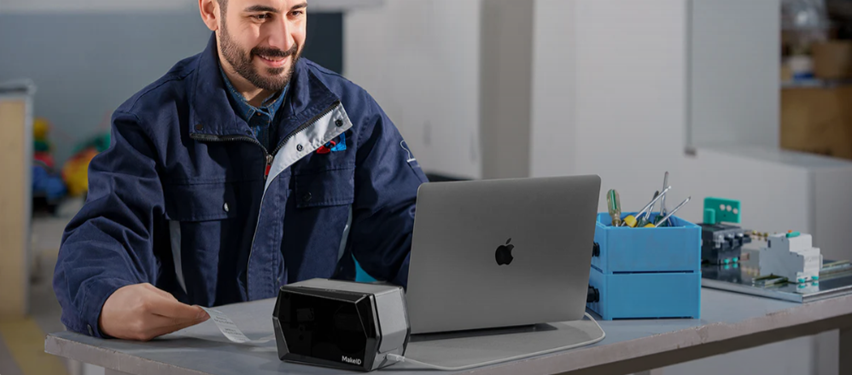Why Do You Need a Desktop Label Printer?

Printers for desktop labels may appear like tiny office equipment however their purpose goes well beyond the realm of the convenience. Let's look at how they can be of value:
Shipping and E-commerce: essential to speedy, accurate labelling of shipping containers, barcodes and returns. It saves time and helps avoid from making mistakes.
Retail: Design clear, sturdy shelf and price tags that are fast and consistent.
Office: Streamlines filing, asset management through labeling organized.
Healthcare and Education: Use to create patient files, sample inventory, library items.
Home and DIY: Great storage, craft, and for household organization.
In short, if your work process involves organizing, tracking, as well as shipping, having a label for your desktop printer is much more than a practicality, it's an absolute necessity.
Key Factors to Consider Before Buying
1. Printing Technology
Direct Thermal Printing:
Makes use of heat-sensitive paper.
There is no need for ribbons or ink.
Ideal for labels that are short-term (e.g. labelling for shipping).
Labels become faded over time if exposed to sunlight or heat.
Thermal Transfer Printing:
Utilizes a ribbon for transferring the ink on labels.
Produces more durable, long-lasting labels.
Ideal for labeling of products Tags for assets, product labels for any use that demands long-lasting durability.
Costs of supply are higher because of ribbons.
2. Print Resolution & Speed
Resolution (DPI):
The 203 DPI resolution is enough for barcodes and shipping labels.
300-600 DPI is ideal for graphic, small-sized text or labels for products where clarity is essential.
Speed:
Make sure you choose printers that print 4 to 6 inches per second when printing in large quantities.
In smaller companies speed is acceptable however speed directly impacts productivity.
3. Connectivity Options
USB: Reliable, standard and universal.
Bluetooth: Ideal for mobile use or desk space that is limited.
Wi-Fi/Ethernet: Ideal for offices that share several users.
Integration: Some models are directly connected to platforms such as Amazon Seller Central, eBay and Shopify, which is a huge benefit for sellers selling online.
4. Label Size & Material Compatibility
Label printers may not be flexible. Before you buy, check:
Maximum and minimal width of the label.
If the printer can print continuously-printed labels, cut labels or other special materials (waterproof or heat-resistant chemical-resistant).
5. Software & Integration
The most effective label printers come with an easy-to-use program that allows you to create and personalize templates. Some are integrated directly with tools for business for example:
Microsoft Office
Software for managing inventory
Platforms for e-commerce (Amazon, Shopify, WooCommerce)
Integration is easy and helps reduce time and errors, which are key aspects for companies looking to scale their operations.
6. Cost Considerations
The most common error is focusing solely on the cost of purchase. Total cost of ownership (TCO) comprises:
Cost of printing
Ribbons or labels for label rolls (ongoing cost of supplies)
Parts for maintenance and replacement
Support for customer and warranty support is available.
A general rule of thumb: for large users buying a premium printer can save money over the long term.
Popular Desktop Label Printer Brands & Models
There are a variety of brands that dominate the desktop print market. They each having distinct strengths:
Brother: Popular for its inexpensive, user-friendly designs that are ideal for both home and office users.
Dymo: Ideal for light to medium use, it is popular for small offices as well as home management.
Make ID: A top in durability and industrial performance. It is widely employed in retail, logistics as well as healthcare.
Each brand has models that cater to different types of users, from informal home organization to business needs.
Common Mistakes to Avoid When Buying
Concentrating only on the upfront cost: Printers that are cheap usually come with costly labels and higher cost over time.
Inattention to the resolution of your printer: Printers with low-DPI could render barcodes inaccessible which can lead to issues with compliance.
Compatibility issues: Printing devices do not can be used with all platforms, such as Amazon FBA as well as Shopify.
Buy without thinking about scalability: If your business expands and you need to upgrade your printer, you'll be disappointed with the wrong printer to keep up.
Practices for Using a Desktop Label Printer
To make the most of your investment:
Make sure you use high-quality labels. Low-grade labels can block printers and deteriorate quickly.
Clean the print head regularly: The buildup of dust and dirt can affect the quality of prints and reduce the life of the print head.
Labels must be properly stored: Store the rolls in a cool, dry location to avoid the labels from fading and curling.
Optimize templates: Templates that are pre-set for product and shipping labels help to reduce time and human errors.
Conclusion
Selecting the best desktop printer for your desktop is not about finding the lowest-cost model, but more about coordinating features with your preferences.
Making the investment in the most efficient printer increases efficiency, decreases operational errors and helps save money in the long run. If you take into consideration the printing technology as well as resolution, connectivity and the total cost of ownership, you'll be able to make a choice that will pay dividends in reliability and productivity.

1 comment
4u1ppr